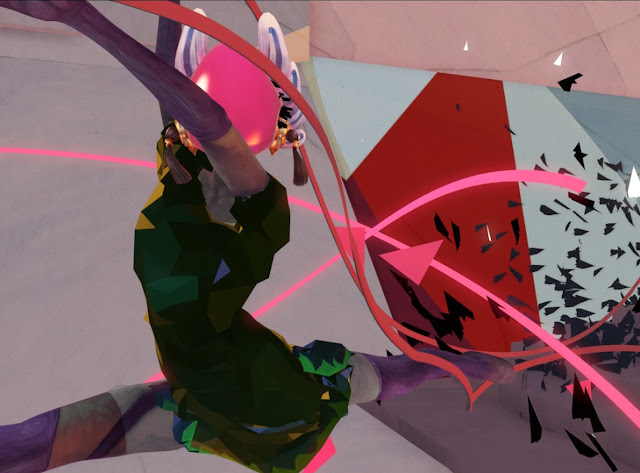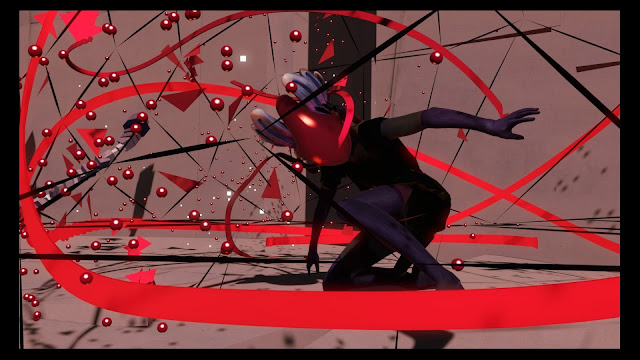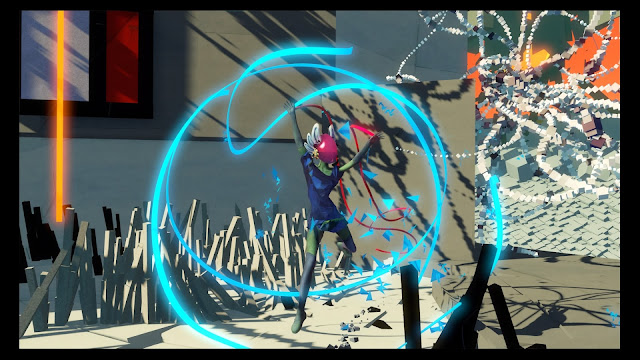Review by Matt S.
It would be easy to dismiss Bound as being yet another artsy game developed by hipsters that doesn’t play as “cool” as the latest shootybang. I’m sure a lot of people will do just that to it. As usual with artsy hipster games, those critics are missing the point. Reflective, heart wrenching, and beautiful, Bound is the kind of game that gives me faith that this industry is developing more nuance and artistry, once you get past the blockbuster trite.
Related reading: It has been a good couple of weeks for art games on PlayStation 4. Matt C reviews ABZU, which will appeal to the same people this game does.
Bound starts with you in control of a heavily pregnant woman, slowly walking across a serene beach. She sits down and pulls out a notebook, which has a series of children’s drawings in it. The next thing we know we’re in a surreal, highly abstract world, and in control of a masked young girl. She’s a gymnast or ballerina, and her movements are catlike in grace. She can conjure up a wall of gymnast’s ribbons to protect her from the triangles that represent fire, or other dangers. Her task is to move through a labyrinth, dodging these dangers. The goal is sentimentality and nostalgia; at the end of each labyrinth she recounts some memories of her childhood, before being whisked back to reality, where, pregnant again, she progresses on her own quest across the beach some more.
This nostalgia is fascinating in its own right. Often, an artist will use old age as the catalyst to reflect back on the experience of youth, with age being the barrier to the excitement, adventures, and energy of experiences long gone. But here, in Bound, it’s pregnancy that is holding the woman down from the freedom she enjoyed as a child. The title – Bound – therefore has dual meanings – it’s the movement that the ballerina makes, and it also represents bondage – the woman is tied down by her pregnancy from the freedom she wistfully re-experiences through her notebook.
For of my review 🙂 https://t.co/TQyVg2HfpB pic.twitter.com/KDhjftl4Wi— Miku McMikuFace (@DigitallyDownld) August 15, 2016
That’s not to say the impending child is a burden, though. There’s no indication through the game’s intense narrative that she doesn’t want her child. Indeed, the sheer femininity that’s on display through the narrative and game design suggests a great deal of respect for the experience of a woman in the world. Rather, Bound’s mother seems to be concerned for the role – her role – of motherhood. Without wanting to give the narrative away, the childhood memories displayed through Bound are not those of a happy family, and indeed the reason that the world the ballerina/ gymnast traverses is so abstracted is to suggest that for her, as a child, dance was an escape from normal life. It’s easy to imagine this young woman is deeply concerned about the childhood her own son or daughter will experience.
It’s a heart-wrenching, hugely emotive contrast to witness such beautiful, graceful dance moves and music juxtapose so harshly on the glimpses of life that the little girl experiences. Bound is the beauty of ballet or rhythmic gymnastics, the most beautiful art and sport in the world, respectively, and going in I was not expecting such overwhelming melancholia in its themes at times. I left the game feeling deeply conflicted, but deeply reflective on what I had just experienced, in a manner not dissimilar to the ending of Journey. Delivered in such a heartfelt manner, it is clear that this game meant a great deal to the development team behind it, and covers the full gamut of human experiences, from soaring joy to utter dread.
It’s not the most complex game to play, with minimal capacity to fail and very linear challenge. For the most part you’re going to be making your way through simple platforming paths, with clearly signposted ways to navigate its challenges. But then, Bound is a narrative, not a “gameplay” game, and what is fascinating about it is that you’re able to tackle the levels in any order, and the way the narrative pieces fit together is such that the path you take will adjust your interpretation of events. Again, without trying to give anything away, there are multiple actors in play in Bound, and your sympathies are meant to change based on the order that you first experience the events that happen to them.
For those that become invested with Bound, there are additional ways to extend the longevity in it, and add gameplay-like challenges to it. The developers have a sincere hope that the game will prove popular with speedrunners, and I expect that some will enjoy that challenge, as levels are relatively short, and there’s enough complexity to the way the girl moves that there is a learning curve to people who want to make her parkour around quickly.
For the more aesthetically inclined there is also a photo mode, which I found absolutely wonderful. Through this you’re able to pause the girl in the middle of movement, and have complete control over a deep host of camera controls that allow you to take dynamic, and beautiful, photos of ballet (or rhythmic gymnastics) in movement. It’s unfortunate that I experienced the rare bug in this mode and this mode alone, though. Sometimes when pausing to take photos the screen does some funny things with its colours, or objects render weirdly. Thankfully, that’s infrequent and rarely detrimental to the overall experience.
As someone who loves ballet (and gymnastics) photography, this mode alone was all I really needed, especially when the developers have nailed the movement, grace, and beauty of ballet this well. The eye for detail in the way the girl places her feet in moving, through to the physical accuracy of her leaps and pivots, right through to her idle animations, which show some of the common stretches that a ballet dancer does in preparing for a performance, show that the developers spent a lot of time around ballet and/or rhythmic gymnastics to understand the behaviour and form of the art properly. Static screenshots don’t really do this one justice, but in motion, Bound is breathtaking, and one of the rare times that the artistry of ballet has found purpose in a game.
Bound also would not be the same without those abstract environments. They’re used to differentiate the real world from the hazy nostalgia of youth, but it’s visually attesting, minimalist, and focused, which helps to guide the player through the world with no need for user interfaces, beyond a couple of tutorial prompts the first time a gameplay feature is encountered. The art itself subtly encourages player’s behaviour through the game, while focusing attention on the girl and her movement, helping to build empathy with her.
2016 has really seen the emergence of games that art and/or experience first, and traditional entertainment product second. Bound isn’t there for people who want to mash a bunch of buttons before declaring how great the are for mashing the buttons better or faster than the other guys. Bound isn’t going to be an eSport, and doesn’t really care about that. Nor is Bound for people looking to unwind after a hard day’s work with passive entertainment. There’s nothing wrong with games being either of those things, but Bound is for a third audience; it’s for the people that want something thoughtful, meaningful, and intelligent. For that audience, this game is about as good as they come. As a member of that audience myself, it’s right up there with my favourite games of the year.
– Matt S.
Editor-in-Chief
Find me on Twitter: @digitallydownld










